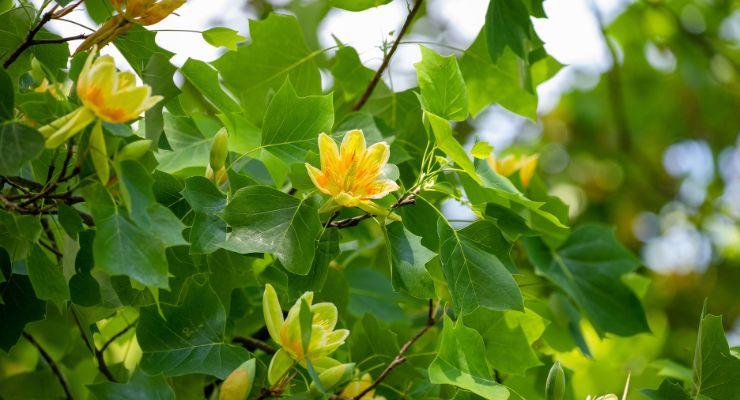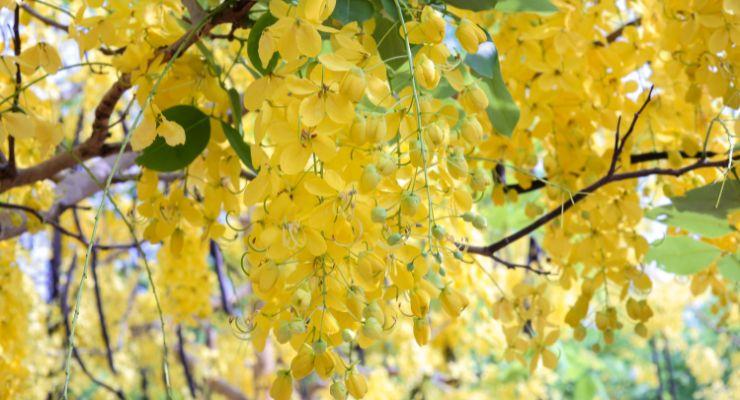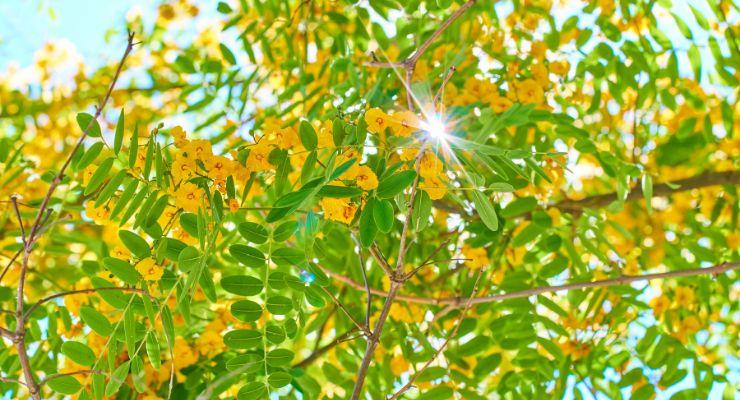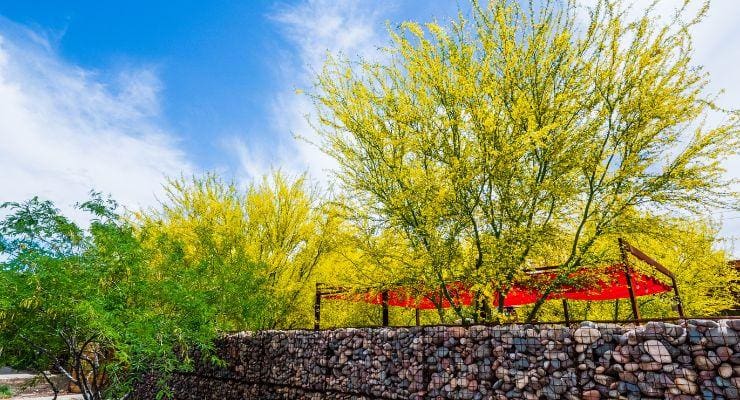Are you looking to add a splash of yellow color to your yard? If so, yellow flowering trees and shrubs are a perfect choice! Not only do they provide a beautiful burst of yellow during the spring and summer months, but they also have many other benefits. From providing shade in hot climates to attracting wildlife, yellow flowering trees can be an excellent addition for homeowners.
In this blog post, we’ll discuss some of the best varieties as well as tips for caring for them. Read on to find out more about yellow flowering trees and how you can incorporate them into your landscape!
Trees with Yellow Flowers
Yellow buckeye (Aesculus flava)
Introduce the Yellow Buckeye (Aesculus flava) as a majestic, deciduous tree that’s a true North American native. This tree thrives in full sun and moist, rich soils, making it the perfect addition to stream banks and other areas with deep soil layers. It’s hardy in zones 4-8, primarily along the Appalachian mountains of the south, and it’s a sight to behold.
The yellow buckeye is truly fascinating, with its fruit splitting open in the fall to reveal seeds that resemble a deer’s eye. It was introduced into cultivation in 1764 and now includes some grand specimens- like the national champion at Spring Grove Cemetery in Cincinnati, Ohio! Standing at an impressive 136 feet tall, it continues to awe visitors from far and wide.
Aside from its impressive size, the yellow buckeye is also known for its striking features, such as bright yellow blossoms clustered into panicles, large palm-shaped leaves, and distinctive seeds.
As autumn rolls around, this tree showcases vibrant reddish-orange foliage, adding an extra dose of beauty during colder months.

Golden chain tree (Laburnum)
Next on the list is the dazzling Golden Chain Tree – a magnificent deciduous beauty that will add a pop of sunny yellow to your garden every spring! Standing tall at up to 30 feet, this tree is adorned with smooth bark, lush dark green branches, and drooping twigs that bring a touch of elegance to your landscape.
The best time to plant this tree is in mid to late spring in USDA planting zones 5 to 7. It will flourish in a sunny spot with well-drained alkaline loam soil and a little extra TLC in the form of regular watering.
In May or June, the Golden Chain Tree bursts into bloom with clusters of bright yellow, lightly fragrant flowers that will fill your garden with a sweet aroma. And the beauty doesn’t stop there, its glossy leaves offer stunning fall colors to continue bringing life to your garden months after its initial bloom.
This yellow chain tree is a true delight to have in any garden, it’s easy to care for and will provide gorgeous flowers and vibrant fall colors year after year.
If you’re on the hunt for a stunning, low-maintenance flowering tree to brighten your garden space, look no further than this yellow chain tree! Its bright yellow blooms and fragrant leaves are only outshined by its captivating fall colors.
Golden Chain tree will be an exquisite addition to your outdoor oasis for many years ahead – guaranteed.

Tulip Tree (Liriodendron Tulipiferah)
Liriodendron tulipifera, also known as the tulip tree, American tulip tree, tulipwood, tuliptree, or tulip poplar is the North American representative of the two-species genus Liriodendron.
This tree is indigenous to the eastern regions of North America and can tower up to 150 feet in height when grown in untouched forests located within the Appalachian Mountains.
The tallest known tulip tree is the Fork Ridge Tulip Tree located in the Great Smoky Mountains of North Carolina, which has been measured to be 191 feet 10 inches in height. The tulip tree is a fast-growing species that is known for its lack of common problems such as weak wood strength and short lifespan.
It prefers deep, rich, and moist soil and is common throughout the Southern United States. From spring to early fall, the tulip tree makes for an excellent planting option.
It requires full sun exposure, with a minimum of 6 hours of direct, unfiltered sunlight per day. It is adaptable to Hardiness Zones 4–9.
It is the state tree of Indiana, Kentucky, and Tennessee, and produces large quantities of nectar from its pale green or yellow flowers with an orange band on the tepals.

Yellow trumpet tree (Brugmansia)
The yellow trumpet tree, also known as the Brugmansia, is a dazzling yellow-flowered delight that hails from Ecuador and Venezuela.
These broadleaf evergreens love to bask in the sun and relish in organically rich soil, making a statement in any garden with their fragrant yellow blooms that come in a range of hues from gold to orange, peach, and pink, from summer to fall.
To keep your Brugmansia thriving, it’s essential to provide plenty of water, as well as a good dose of 15-30-15 or 10-50-10 fertilizer during the hot summer months.
As the temperatures drop in late summer or fall, reduce the watering and stop the fertilizing to prepare your plant for its winter dormancy, making sure to move container plants indoors.
This stunning tree is best grown in zones 9-11 and is sure to light up your garden with its brilliant yellow blossoms.

Magnolia butterfly tree
The Magnolia ‘Butterflies’ is a hybrid magnolia tree that is sure to brighten up any garden. Created by cross-breeding Magnolia acuminata and Magnolia denudata, this tree produces stunning bright yellow flowers during the early spring. With its attractive upright form, the
Magnolia ‘Butterflies’ is a versatile tree that can thrive in full sun or partial shade, as well as in colder and hotter climates.
Additionally, its root system allows it to be planted with other perennials, groundcover, and smaller shrubs without causing any disturbance around them.
This yellow flowering tree is known for its big double blooms with creamy yellow hues, making it an eye-catching addition to any garden.
Growing the Magnolia ‘Butterflies’ requires moist soil that has a neutral to slightly acidic pH level balance. Mulching around the root system will help retain moisture and protect against extreme temperatures during winter months. Pruning requirements are minimal and summer is often the best season for this task when the tree is fully leafed out.
All in all, the Magnolia ‘Butterflies’ is a unique hybrid magnolia that works well across hardiness zones 4 through 9 and adds beautiful bright color to gardens within these regions in the springtime each year.
With its ability to adapt to different climates and its minimal pruning requirements, it’s no wonder that this yellow flowering tree is a favorite among gardeners.

Golden Shower (Cassia Fistula)
The Golden Shower Tree (Cassia fistula), also known as the Indian laburnum, purging cassia, or pudding-pipe tree, is a stunning sight to behold when in full bloom. With its fast growth rate, it can reach heights of 30 to 40 feet and widths of up to 40 feet with a distinctive grayish brown bark and delicate pinnately compound leaves.
What truly sets this ornamental tree apart, however, is its vibrant yellow flower display that coat the entire tree in late spring.
For optimal growth and blooming, the Golden Shower Tree should be placed in full sun with well-drained soil and regular watering until its roots are established. This water-loving plant makes a fantastic backdrop for other garden plantings or an eye-catching border arrangement.
Maintaining its shape through regular pruning not only helps keep its form but also encourages even more yellow flower production each season.
Although it can tolerate dry conditions once established, occasional deep watering during dry spells is beneficial for optimal growth and blooming. A balanced fertilizer every couple of months will also help this yellow-flowering tree thrive.

Tabebuia tree
Get ready to add a pop of sunshine to your yard with the Tabebuia, also known as the trumpet tree or robles, these beautiful trees are native to Central and South Florida and love sunny weather and moist soil.
With the ability to reach heights of 25-160 feet, the Tabebuia is a true statement piece in any outdoor space. The eye-catching blooms come in a variety of colors including pink, lavender-pink, and of course, bright golden yellow blossoms.
With the proper care and attention, these hardy trees (found in USDA planting zones 9b to 11) will bloom each year and provide a stunning display of color. To keep your Tabebuia healthy, water it regularly and prune it as necessary. Start growing this vibrant and simple-to-care-for tree today and enjoy the sunny yellow flowers for years to come!

Tipu Tree (Tipuana tipu)
The Tipu Tree, scientifically known as Tipuana tipu, is a standout among yellow blooming trees. This South American beauty is a fast-growing semi-deciduous tree with a flat crown that often spreads wider than its height.
Its bark is textured with fissures and adds interest to its appearance. During the warm months, it boasts gorgeous orange or yellow flowers that are sure to attract attention in any garden.
Planting the Tipu Tree is an excellent choice for those in warmer climates seeking shade, as it is a low-maintenance option that thrives in full sun. Ideal soil for the Tipu Tree is acidic, but it can handle slightly alkaline soil if given regular irrigation during dry spells.
Despite its ease of care, it is important to note that psyllid infestations and invasive roots are common issues with this species. Regular root pruning may be necessary when grown in greenhouses or conservatories.
So, if you’re looking to add some bright and sunny yellow flowers to your garden, the Tipu Tree is a great choice! With its low-maintenance requirements, attractive bark, and beautiful blooms, it will be a standout feature for years to come.

Cornelian cherry dogwood (Cornus mas)
Get ready to light up your landscape with the sunshine-yellow blooms of Cornelian cherry dogwood!
This enchanting small tree is native to Europe and western Asia and is a true early bird, bursting into bloom in early spring before many other trees have even awakened from their winter slumber.
With an upright form that reaches 15 to 25 feet in height and 12 to 18 feet in spread, Cornelian cherry dogwood is perfect for adding a pop of color to your garden, near a patio, or as a stunning specimen plant.
This slow-growing tree thrives in well-drained, nutrient-rich soil with plenty of humus, and can even handle slightly alkaline conditions. However, if your soil is poorly drained, adding some sand can ensure Cornelian cherry dogwood gets the right mix of moisture and air to thrive. This species is also tough enough to endure urban environments with good drainage, making it a versatile addition to any garden.
Whether you’re looking to add a pop of bright yellow to your garden, or you want to create an eye-catching focal point, Cornelian cherry dogwood is an excellent choice. Its flowers are sure to brighten up your spring days and its attractive form can be pruned regularly to maintain its size and shape, making it a great choice for small gardens or as a low-maintenance hedge.
Get ready to bring some sunshine to your landscape with Cornelian cherry dogwood!

Golden Trumpet Tree (Tablebuia Chrystotricha And Tablebuia Umbellata)
If you’re in desperate need of a sunshine-filled addition to your garden, the golden trumpet tree (Tabebuia chrysotricha) is exactly what you’ve been searching for!
This magnificent tree is native to the dry forests of Mexico, Venezuela, and Ecuador, and is renowned for its golden flowers that bloom in the spring. Growing up to 25-35 feet tall, it’s the perfect addition to any garden looking to make a statement.
Not only is the golden trumpet tree visually stunning, it’s also low maintenance and easy to care for. Simply plant it in full sun and provide it with reasonable fertile soil and moderate moisture, and you’ll be rewarded with a beautiful and thriving tree.
Although young plants may need frequent deep watering during their first few months, established golden trumpet trees are known for their hardiness and low maintenance needs.
If you’re searching for a tree that will truly bring your garden to life, the golden trumpet tree is an ideal selection. With its bright yellow flowers and easy-care nature, it’s a fantastic addition to USDA Hardiness Zones 8B to 11.

Yellow Flowering Trees in California
Bailey acacia (Acacia baileyana)
Acacia Baileyana, also known as the Cootamundra Wattle, Bailey Acacia, Golden Mimosa, or Fernleaf Acacia, is a stunning evergreen shrub or small tree that can be found in many parts of California, although it is native to Southeastern Australia. Its leaves have a silvery blue-gray feathery texture that contrasts beautifully with the clusters of yellow flowers that bloom from winter to spring.
This fast-growing tree thrives in full sunlight and prefers hardiness zones between 9 and 11. To maintain optimal soil moisture, ensure to incorporate sand or gravel into the substrate. Additionally, sweet Acacia flourishes in light and fertile soils that have excellent drainage properties.
The appearance of this particular species includes 16 up to 40 tiny linear leaflets, and fragrant yellow flowers that create a unique beauty that can be admired during its growing season.

Popular Trees with Yellow Flowers in Arizona
Palo Brea (Parkinsonia praecox)
Palo Brea, also known as Parkinsonia praecox or Sonoran Palo Verde, is a semi-evergreen tree native to Mexico but well-known in the states of Arizona and Texas. It has an impressive umbrella-shaped canopy made up of gracefully interwoven branches with small pinnately compound dark green foliage. Its trunk and branches are easily identifiable due to its bright chartreuse bark and twisting shape.
This beautiful yellow-blossomed tree is the perfect addition to any desert garden, standing tall at a commanding height of 20 – 25 ft and just as wide!
In springtime, Palo Brea produces clusters of gorgeous yellow flowers that add a unique pop of color to any garden setting. It is suitable for USDA Hardiness Zones 9 through 11 and is often chosen for its timeless beauty that will last throughout the year in all climates within this range.
Palo Brea trees have become highly sought after by gardeners of all levels due to their hardy nature and adaptability. They require lots of sunlight, as well as regular watering, to thrive throughout the seasons. Notoriously easy to care for with minimal effort on behalf of experienced horticulturalists or gardening hobbyists alike, these yellow-flowering specimens offer a unique addition that can survive even when conditions may be less than ideal.

Companion Planting with Yellow Flowering Trees
Yellow flowering trees can be paired with other plants to create a beautiful and harmonious garden or landscape. Some great companions for yellow flowering trees include:
- Purple-flowering plants, such as lilacs or irises, will provide a striking contrast to the yellow flowers of your tree.
- Evergreen shrubs, such as boxwood or holly, will provide a backdrop for your yellow flowering tree and keep your garden looking great all year round.
- Spring-flowering bulbs, such as daffodils or tulips, will complement your yellow flowering tree by providing an additional burst of color in the spring.
Conclusion
Yellow flowering trees are an ideal choice for homeowners looking to add a splash of yellow to their gardens. These trees bloom in the spring, providing a colorful backdrop for backyard gatherings and outdoor activities.
They require minimal care and will thrive in most climates, making them a smart investment for any home garden. Whether you choose Bailey Acacia from California or Palo Brea from Arizona, yellow flowering trees can be the perfect addition to any landscape.
If looking for smaller additions to the garden, check out the list of stunning yellow flowering shrubs here.
With careful companion planting and regular maintenance, these yellow-blossomed beauties will grace your garden for many years to come!

